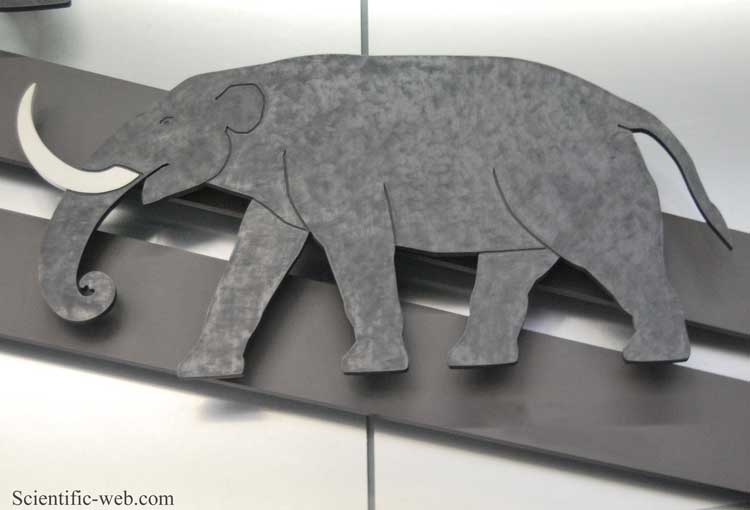
Stegomastodon sp. , Photo: Michael Lahanas
Superregnum: Eukaryota
Regnum: Animalia
Subregnum: Eumetazoa
Cladus: Bilateria
Cladus: Nephrozoa
Superphylum: Deuterostomia
Phylum: Chordata
Cladus: Craniata
Subphylum: Vertebrata
Infraphylum: Gnathostomata
Superclassis: Tetrapoda
Cladus: Reptiliomorpha
Cladus: Amniota
Cladus: Synapsida
Cladus: Eupelycosauria
Cladus: Sphenacodontia
Cladus: Sphenacodontoidea
OrdoTherapsida
Cladus: Theriodontia
Subordo: Cynodontia
Cladus: Mammaliaformes
Classis: Mammalia
Subclassis: Trechnotheria
Infraclassis: Zatheria
Supercohort: Theria
Cohort: Eutheria
Magnordo: Epitheria
Superordo: Afrotheria
Cladus: Paenungulata
Ordo: Proboscidea
Subordo: Elephantiformes
Cladus: Elephantimorpha
Cladus: Elephantida
Familia: †Gomphotheriidae
Genus: Stegomastodon
Stegomastodon ('roof breast tooth') is an extinct genus of gomphotheres, a family of proboscideans. It ranged throughout North America from the early Blancan ~4 Ma, to the early Irvingtonian (~1.2 Ma). The South American species have been synonymized with Notiomastodon platensis.
Species
The following definite species have been described:[1]
S. aftoniae
S. mirificus
S. nebrascensis
S. primitivus
S. waringi is considered synonymous with S. platensis. A dispute now exists over whether S. platensis should remain within the North and Central American genus Stegomastodon or should be moved over to the exclusively South American genus Notiomastodon.[2][3][4] The genus Haplomastodon is regarded as synonymous with the South American Stegomastodon species.[5][6]
Origin and evolution
Stegomastodon is considered by some to be derived from New World populations of Gomphotherium. The number of species within the genus has varied between S. mirificus being the only valid species, to Osborn's seven species of “ascending mutations” (S. primitivus, S. successor, S. mirificus, S. chapmani, S. texanus, S. arizonae and S. aftoniae) Lucas et al., 2013 accepted 3 overlapping chronospecies S. primitivus, S. mirificus S. aftoniae.[7]
Description
Restoration of S. mirificus
Stegomastodon mirificus is known from NMNH 10707, a roughly 30-year-old male, of which most of the skeleton has been found. Alive, it stood about 2.6 m (8.5 ft) tall, with a weight around 4.7 tonnes (4.6 long tons; 5.2 short tons).[8] Like modern elephants, but unlike most of its closer relatives, it had just two tusks, which curved upward and were about 3.5 m (11.5 ft) long. The tall, head and robust lower jaw suggest a strong vertical bite. Stegomastodon's molars were covered in enamel and had a complex pattern of ridges and knobbly protrusions on them, giving the creature a large chewing surface that suggests it was a grazer.[7] During the early Irvingtonian, Stegomastodon was replaced by Mammuthus, which was presumably a more efficient grazer. Its brain weighed about 11 lb (5 kg).
The genus lived in North America from the Zanclean of the Pliocene to the Late Pleistocene. The most recent specimens in the fossil record originate from Jalisco, Mexico and date to 28,000 BP,[9] but this late date is over 1 million years after the last confirmed specimens.
Taxonomy
The South American Stegomastodon fossils were reassigned to Notiomastodon,[10] though in literature the outdated genus and species names continued to be used until 2016.[11]
Revised taxonomy of Stegomastodon and other trilophodont gomphotheres according to Mothé et al., 2017:[12]
|
†Gomphotheriidae (Gomphotheres)
|
|
||||||||||||||||||||||||||||||||||||||||||
References
iconPaleontology portal
Stegomastodon at Fossilworks.org
Labarca, R.; Alberdi, M.T.; Prado, J.L.; Mansilla, P.; Mourgues, F.A. (18 April 2016). "Nuevas evidencias acerca de la presencia de Stegomastodon platensis Ameghino, 1888, Proboscidea: Gomphotheriidae, en el Pleistoceno tardío de Chile central/New evidences on the presence of Stegomastodon platensis Ameghino, 1888, Proboscidea: Gomphotheriidae, in the Late Pleistocene of Central Chile". Estudios Geológicos. 72.
Mothé, Dimila; dos Santos Avilla, Leonardo; Asevedo, Lidiane; Borges-Silva, Leon; Rosas, Mariane; Labarca-Encina, Rafael; Souberlich, Ricardo; Soibelzon, Esteban; Roman-Carrion, José Luis; Ríos, Sergio D.; Rincon, Ascanio D.; Cardoso de Oliveira, Gina; Pereira Lopes, Renato (30 September 2016). "Sixty years after 'The mastodonts of Brazil': The state of the art of South American proboscideans (Proboscidea, Gomphotheriidae)" (PDF). Quaternary International. 443: 52–64. Bibcode:2017QuInt.443...52M. doi:10.1016/j.quaint.2016.08.028.
Mothé, Dimila; Ferretti, Marco P.; Avilla, Leonardo S. (2017-06-03). "Running Over the Same Old Ground: Stegomastodon Never Roamed South America". Journal of Mammalian Evolution. 26 (2): 165–177. doi:10.1007/s10914-017-9392-y. ISSN 1064-7554. S2CID 23041930.
Lucas, Spencer G.; Yuan, Wang; Min, Liu (2013-01-01). "The palaeobiogeography of South American gomphotheres". Journal of Palaeogeography. 2 (1): 19–40. doi:10.3724/SP.J.1261.2013.00015 (inactive 31 October 2021).
Dantas, Mário André Trindade; Xavier, Márcia Cristina Teles; França, Lucas de Melo; Cozzuol, Mario Alberto; Ribeiro, Adauto de Souza; Figueiredo, Ana Maria Graciano; Kinoshita, Angela; Baffa, Oswaldo (2013-12-13). "A review of the time scale and potential geographic distribution of Notiomastodon platensis (Ameghino, 1888) in the late Pleistocene of South America" (PDF). Quaternary International. Quaternary in South America: recent research initiatives. 317: 73–79. Bibcode:2013QuInt.317...73D. doi:10.1016/j.quaint.2013.06.031.
Lucas, Spencer G. Taxonomy and evolution of the Plio-Pleistocene proboscidean Stegomastodon in North America. OCLC 798103439.
Larramendi, A. (2016). "Shoulder height, body mass and shape of proboscideans" (PDF). Acta Palaeontologica Polonica. 61. doi:10.4202/app.00136.2014. S2CID 2092950.
Alberdi, María Teresa; Juárez-Woo, Javier; Polaco, Oscar J.; Arroyo-Cabrales, Joaquín (2009-02-01). "Description of the most complete skeleton of Stegomastodon (Mammalia, Gomphotheriidae) recorded for the Mexican Late Pleistocene". Neues Jahrbuch für Geologie und Paläontologie, Abhandlungen. 251 (2): 239–255. doi:10.1127/0077-7749/2009/0251-0239.
Mothé, Dimila; Avilla, Leonardo S.; Cozzuol, Mário; Winck, Gisele R. (25 October 2012). "Taxonomic revision of the Quaternary gomphotheres (Mammalia: Proboscidea: Gomphotheriidae) from the South American lowlands". Quaternary International. 276–277: 2–7. Bibcode:2012QuInt.276....2M. doi:10.1016/j.quaint.2011.05.018.
Labarca, Rafael; Alberdi, María Teresa; Prado, José Luis; Mansilla, P.; Mourgues, F.A. (2016). "Nuevas evidencias acerca de la presencia de Stegomastodon platensis Ameghino, 1888, Proboscidea: Gomphotheriidae, en el Pleistoceno tardío de Chile central". Estudios Geológicos. 72: e046. doi:10.3989/egeol.42199.385.
Mothé, Dimila; dos Santos Avilla, Leonardo; Asevedo, Lidiane; Borges-Silva, Leon; Rosas, Mariane; Labarca-Encina, Rafael; Souberlich, Ricardo; Soibelzon, Esteban; Roman-Carrion, José Luis; Ríos, Sergio D.; Rincon, Ascanio D.; de Oliveira, Gina Cardoso; Lopes, Renato Pereira (2 July 2017). "Sixty years after 'The mastodonts of Brazil': The state of the art of South American proboscideans (Proboscidea, Gomphotheriidae)". Quaternary International. 443: 52–64. Bibcode:2017QuInt.443...52M. doi:10.1016/j.quaint.2016.08.028.
Retrieved from "http://en.wikipedia.org/"
All text is available under the terms of the GNU Free Documentation License

